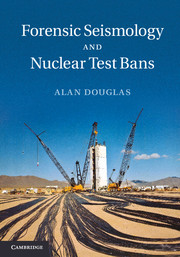Book contents
- Frontmatter
- Contents
- Preface
- Abbreviations and mathematical symbols
- Prologue
- 1 Seismology: ancient and modern
- 2 Statistical solutions to seismological problems
- 3 Seismograms as time series
- 4 Seismographs and seismograms
- 5 Seismometer arrays and processing methods
- 6 Seismogram interpretation and synthesis
- 7 Hypocentres and P travel times
- 8 Seismic magnitudes
- 9 Seismic source identification
- 10 Epilogue
- Appendix A P and S radiation from a double-couple source
- Appendix B Normal equations for analysis of variance
- Appendix C Some uses of the FFT
- Appendix D Anelastic attenuation
- Appendix E The relation of the transient and steady-state responses
- Appendix F Seismometer–galvanometer systems
- Appendix G SNI from summing array recordings
- Appendix H The equations for computing MP filters
- Appendix I Circular arrays
- Appendix J Geometrical spreading when S reflects as sP
- Appendix K The Fourier integral for a dispersed wave train
- Appendix L Tables of explosions and earthquakes
- Appendix M Album of body-wave seismograms
- Appendix N Exercises
- References
- Further reading
- Author index
- Index
7 - Hypocentres and P travel times
Published online by Cambridge University Press: 05 March 2013
- Frontmatter
- Contents
- Preface
- Abbreviations and mathematical symbols
- Prologue
- 1 Seismology: ancient and modern
- 2 Statistical solutions to seismological problems
- 3 Seismograms as time series
- 4 Seismographs and seismograms
- 5 Seismometer arrays and processing methods
- 6 Seismogram interpretation and synthesis
- 7 Hypocentres and P travel times
- 8 Seismic magnitudes
- 9 Seismic source identification
- 10 Epilogue
- Appendix A P and S radiation from a double-couple source
- Appendix B Normal equations for analysis of variance
- Appendix C Some uses of the FFT
- Appendix D Anelastic attenuation
- Appendix E The relation of the transient and steady-state responses
- Appendix F Seismometer–galvanometer systems
- Appendix G SNI from summing array recordings
- Appendix H The equations for computing MP filters
- Appendix I Circular arrays
- Appendix J Geometrical spreading when S reflects as sP
- Appendix K The Fourier integral for a dispersed wave train
- Appendix L Tables of explosions and earthquakes
- Appendix M Album of body-wave seismograms
- Appendix N Exercises
- References
- Further reading
- Author index
- Index
Summary
Keep a movin' Jess,
'Twas an A-blast says Frank Press,
'Cause the P exceeds the S,
And that's why we search I guess,
For data, hot test data.
Trebor Sirrah (aka Robert Harris) a fault along the PotomacIntroduction
In a 1D earth, given a sufficient network of stations, times and epicentres are orthogonal so that unbiased epicentres can be estimated independently of the travel times; this is clear because if the P arrival times at a circle of stations are constant, the epicentre must be in the centre of the circle whatever the travel time. Networks of stations are not so well distributed in practice but epicentre estimates are still insensitive to travel-time tables, so that given the origin time of at least one earthquake, obtained from observations very close to the epicentre, corrections to travel times can be found by averaging the O–C residuals in a series of small distance ranges. Epicentres can then be revised using the updated travel-time tables. This method of ‘successive approximation’, where the tables and then the epicentres are repeatedly revised until corrections become small enough to neglect, is that used by Jeffreys and Bullen (1940).
The travel-time analysis carried out by Herrin et al. (1968) to derive the 1968 Tables and that of Kennett and Engdahl (1991) to derive the iasp91 Tables also use successive approximation. Herrin et al. (1968) estimate station effects but, just as distance corrections are found by grouping residuals in distance ranges and averaging, so station effects are found by grouping residuals by station and averaging. Kennett and Engdahl (1991) do not allow for station effects.
- Type
- Chapter
- Information
- Forensic Seismology and Nuclear Test Bans , pp. 278 - 298Publisher: Cambridge University PressPrint publication year: 2013



